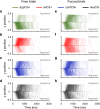Overcoming Automatic Behavioral Tendencies in Approach-Avoidance Conflict Decisions
- PMID: 40611679
- PMCID: PMC12232122
- DOI: 10.1111/psyp.70101
Overcoming Automatic Behavioral Tendencies in Approach-Avoidance Conflict Decisions
Abstract
Adequate control over automatic responses to affective stimuli is crucial for adaptive goal-oriented behavior. However, it remains unclear how individuals overcome automatic approach-avoidance tendencies to appetitive and aversive stimuli. Here we examined free versus forced approach-avoidance decisions to four conditioned stimuli (CSs), which were previously paired with either a single aversive (avCS+) or appetitive outcome (appCS+), both (i.e., conflicting) outcomes (confCS+), or no outcome (neuCS-). These CSs were presented in an anticipation phase before participants could use a joystick to either approach and obtain CS-specific outcomes or avoid without getting anything. Response times, subjective ratings, heart rate, and eye-tracking data were recorded in N = 75 participants. Results revealed that for single outcomes, concordant responses (e.g., avoidance to the avCS+) were faster than forced discordant responses (e.g., approach to the avCS+). During anticipation, gaze fixations shifted towards the spatial location associated with the concordant response for single-outcome stimuli (e.g., upward for avoidance of avCS+). Conflicting stimuli elicited intermediate behavioral and gaze patterns at the group level, while exploratory analyses revealed substantial individual differences: High avoiders (i.e., participants showing an overall high proportion of avoidance) exhibited slower approach responses and greater threat-focused visual attention compared to low avoiders. Decreased heart rate in response to all CSs suggests a general preparation of behavioral responses, while increased pupil dilation during the anticipation of aversive stimuli indicates threat-related processing. These findings suggest that competing outcomes can amplify individual differences in motivational salience and therefore might inspire clinical interventions focused on inhibiting disorder-specific behavioral tendencies.
Keywords: approach‐avoidance conflict; gaze dispersion; inhibitory control; motivated behavior; response time.
© 2025 The Author(s). Psychophysiology published by Wiley Periodicals LLC on behalf of Society for Psychophysiological Research.
Conflict of interest statement
The authors declare no conflicts of interest.
Figures





References
MeSH terms
Grants and funding
LinkOut - more resources
Full Text Sources

